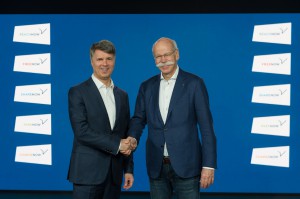Just days after they announced plans to combine their mobility services operations, BMW and Daimler AG now say they will team up on the development of self-driving vehicles.
The move is meant to help them share costs and speed to market a technology many expect will radically transform the auto industry over the coming decades. Autonomous vehicles also could anchor some of the new ride- and car-sharing services the German automakers plan to roll out under their earlier joint venture – and help them fend off upstart rivals such as Waymo, Uber and Tesla.
“Initially, the focus will be on advancing the development of next-generation technologies for driver assistance systems, automated driving on highways and parking features,” the automakers said in a statement announcing the autonomous driving partnership.
Both manufacturers already offer customers a mix of advanced driver assistance systems, or ADAS, such as forward collision warning with automatic emergency braking. And some of their products can be operated hands-free under certain circumstances, typically limited-access highways. Longer-term, however, the goal is to allow motorists to turn complete control over to the vehicle and even eliminate the driver entirely, something that is seen as a critical goal for future ride-sharing operations.
(BMW, Daimler launching new ride-sharing service, other mobility ventures. Click Here for the story.)

BMW Chief Harald Krueger, left, and Daimler AG Chairman Dieter Zetsche continue to make new deals on partnerships.
“Joint development work will be carried out via a scalable architecture covering several stages of automation, with Levels 3 and 4 enabling automated driving on highways,” the new partners said in a statement. “In addition, the two partners plan to discuss the possibility of extending their collaboration to cover higher levels of automation, both on highways and in urban areas.”
But so-called Level 3, 4 and 5 autonomy has proven far more difficult – and costly – than many experts had expected. By some estimates, the industry will spend over $100 billion to develop the necessary technologies over the coming decade.
“We have learned that the development of these systems is a bit like climbing a mountain,” said Michael Hafner, head of automated driving at Mercedes-Benz.
That has spawned a raft of alliances aimed at sharing fundamental learnings while also reducing the financial burden for individual partners. Last autumn, Honda announced it would invest more than $2 billion to team up with General Motors, a move that gives it a stake in GM’s Cruise Automation subsidiary. Ford is negotiating a similar alliance with Volkswagen.
“Combining the strength of our two companies will boost our innovative strength and speed up the spread of this technology,” BMW’s development chief Klaus Froelich said.
(Click Here for more about Daimler, BMW getting U.S. approval for mobility company.)

Ford CEO Jim Hackett, left, and VW AG CEO Herbert Diess show that BMW and Daimler aren't the only companies partnering up.
As has become the norm in an industry undergoing massive transformation, the BMW-Daimler alliance won’t be a monogamous one. The two will continue to work with other partners, Daimler developing autonomous driving technology with German mega-supplier Bosch, and BMW working with Intel and the Israeli-based Mobileye.
Exactly how soon true hands-free technology will come to market is uncertain:
- When it launched its own development program early in the decade, Nissan predicted it would have fully autonomous vehicles in showrooms by 2020. It has now pushed that target back by at least several years;
- Waymo, the Google spin-off considered a leader in the field, last December launched the world’s first autonomous ride-sharing service, Waymo One, in Phoenix. But, for now, it retains a back-up “operator” in each vehicle to take control in an emergency.
- Tesla is promising full autonomy this year but that has triggered plenty of skepticism, observers noting the EV automaker has delayed the roll-out repeatedly.
Nonetheless, a study by Goldman Sachs has predicted the market for ADAS and more advanced technologies will reach $96 billion by 2025, and $290 billion in 2035. That includes both retail and commercial applications. The Boston Consulting Group, meanwhile, has estimated that by 2030 nearly a third of the miles that Americans clock on the road will be in fully self-driving vehicles operated by ride-sharing services.
(To see more about BMW and Daimler merging mobility services operations, Click Here.)
As part of their other new joint venture, BMW and Daimler aim to become major players in both car- and ride-sharing, as well as participants in other areas of mobility services.


I’d like to see a worldwide competition where OEMs from each region join forces: USA, Europe, and Asia. May the best region win.